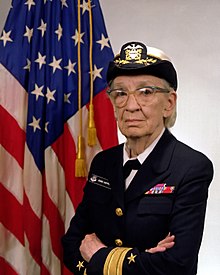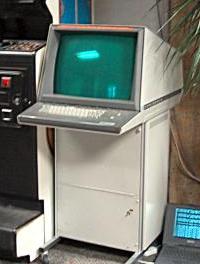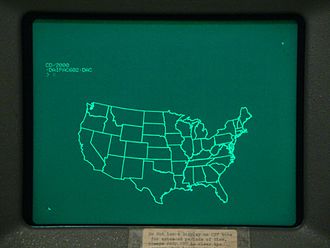General Discussion
Related: Editorials & Other Articles, Issue Forums, Alliance Forums, Region ForumsRADM Grace Murray Hopper-- computer scientist and programmer (COBOL)
Grace Hopper
Grace Murray Hopper

Rear Admiral Grace M. Hopper, 1984
Nickname(s) "Amazing Grace"
Born December 9, 1906
New York City, New York, U.S.
Died January 1, 1992 (aged 85)
Arlington, Virginia, U.S.
Place of burial Arlington National Cemetery
Allegiance United States of America
Service/branch United States Navy
Years of service 1943–1966, 1967–1971, 1972–1986
Rank US-O7 insignia.svg Rear admiral (lower half)
Awards Defense Distinguished Service ribbon.svg Defense Distinguished Service Medal
Legion of Merit ribbon.svg Legion of Merit
Meritorious Service ribbon.svg Meritorious Service Medal
American Campaign Medal ribbon.svg American Campaign Medal
World War II Victory Medal ribbon.svg World War II Victory Medal
National Defense Service Medal ribbon.svg National Defense Service Medal
AFRM with Hourglass Device (Silver).jpg Armed Forces Reserve Medal with two Hourglass Devices
Naval Reserve Medal ribbon.svg Naval Reserve Medal
Presidential Medal of Freedom (posthumous)
Grace Brewster Murray Hopper (née Murray; December 9, 1906 – January 1, 1992) was an American computer scientist and United States Navy Rear Admiral.[1] In 1944, she was one of the first programmers of the Harvard Mark I computer [2] and invented the first compiler for a computer programming language.[3][4][5][6][7]. She popularized the idea of machine-independent programming languages, which led to the development of COBOL, one of the first high-level programming languages.
Owing to her accomplishments and her naval rank, she was sometimes referred to as "Amazing Grace".[8][9] The U.S. Navy Arleigh Burke-class guided-missile destroyer USS Hopper was named for her, as was the Cray XE6 "Hopper" supercomputer at NERSC.[10]
On November 22, 2016, she was posthumously awarded the Presidential Medal of Freedom by President Barack Obama.[11]
. . . . .
https://en.wikipedia.org/wiki/Grace_Hopper
Grace Hopper Biography
Military Leader, Mathematician, Computer Programmer (1906–1992)
2.2K
SHARES
2.1K
0
0
Quick Facts
Name
Grace Hopper
Occupation
Military Leader, Mathematician, Computer Programmer
Birth Date
December 9, 1906
Death Date
January 1, 1992
Education
Yale University, Vassar College
Place of Birth
New York, New York
Place of Death
Arlington, Virginia
Maiden Name
Grace Brewster Murray
Nickname
Grandmother of Cobol
Grandma Cobol
Amazing Grace
Full Name
Grace Brewster Murray Hopper
Synopsis
Early Life
World War II
Career in Computing
Return to the Navy
Later Years and Legacy
Cite This Page
Computer programmer Grace Hopper helped develop a compiler that was a precursor to the widely used COBOL language and became a rear admiral in the U.S. Navy.
IN THESE GROUPS
Famous People in Computing
Famous Yale University Alumni
Famous People Awarded Military Medals
Groundbreaking Women
1 of 4
quotes
“People have an enormous tendency to resist change. They love to say, 'We've always done it this way.' I try to fight that.”
—Grace Hopper
Synopsis
Born in New York City in 1906, Grace Hopper joined the U.S. Navy during World War II and was assigned to program the Mark I computer. She continued to work in computing after the war, leading the team that created the first computer language compiler, which led to the popular COBOL language. She resumed active naval service at the age of 60, becoming a rear admiral before retiring in 1986. Hopper died in Virginia in 1992.
Early Life
Born Grace Brewster Murray in New York City on December 9, 1906, Grace Hopper studied math and physics at Vassar College. After graduating from Vassar in 1928, she proceeded to Yale University, where, in 1930, she received a master's degree in mathematics. That same year, she married Vincent Foster Hopper, becoming Grace Hopper (a name that she kept even after the couple's 1945 divorce). Starting in 1931, Hopper began teaching at Vassar while also continuing to study at Yale, where she earned a Ph.D. in mathematics in 1934—becoming one of the first few woman to earn such a degree.
World War II
Hopper, who became an associate professor at Vassar, continued to teach until World War II compelled her to join the U.S. Naval Reserve in December 1943 (she opted for the Navy, as it had been her grandfather's branch of service). She was commissioned as a lieutenant in June 1944. Given her mathematical background, Hopper was assigned to the Bureau of Ordnance Computation Project at Harvard University, where she learned to program a Mark I computer.
Career in Computing
After the war, Hopper remained with the Navy as a reserve officer. As a research fellow at Harvard, she worked with the Mark II and Mark III computers. She was at Harvard when a moth was found to have shorted out the Mark II, and is sometimes given credit for the invention of the term "computer bug"—though she didn't actually author the term, she did help popularize it.
Wanting to continue to work with computers, Hopper moved into private industry in 1949, first with the Eckert-Mauchly Computer Corporation, then with Remington Rand, where she oversaw programming for the UNIVAC computer. In 1952, her team created the first compiler for computer languages (a compiler renders worded instructions into code that can be read by computers). This compiler was a precursor for the Common Business Oriented Language, or COBOL, a widely adapted language that would be used around the world. Though she did not invent COBOL, Hopper encouraged its adaptation.
. . . .
http://www.biography.com/people/grace-hopper-21406809#synopsis
Grace Hopper Celebration
Connect with us:
Facebook Twitter
Search
Home Attend Schedule Speakers Students & Academics Sponsors FAQ Get Involved About
Amazing Grace
Celebrate Grace Hopper’s life and legacy
Learn More
The Grace Hopper Celebration of Women in Computing is the world's largest gathering of women technologists. It is produced by the Anita Borg Institute and presented in partnership with ACM.
http://ghc.anitaborg.org/
SeattleVet
(5,477 posts)Once before she retired from the Navy, and once when she had become a spokesperson for DEC (Digital Equipment Corporation). I still have a couple of 'Grace Hopper nanoseconds' (and a packet of DEC-logoes 'picoseconds'...ground black pepper).
hunter
(38,311 posts)The nanosecond seems more rational and scientific than the meter, which was originally defined in 1793 as one ten-millionth of the distance from the equator to the North Pole, a measurement that turned out to be a little off, so they made a bar of platinum, put it in icewater and said here, there's your meter. (And it was handy to use that same icewater as the measure of zero degrees Celsius.)
A nanosecond is 11.8 inches.
A U.S. American football field might be 300 nanometers long, which is a little over 98% of 100 yards. Instead of a fifty yard line, you'd have a 150 nanosecond line.
niyad
(113,275 posts)SeattleVet
(5,477 posts)I was working at a big bank in NYC, doing system management and performance tuning on the VAX/VMS systems. The second time I saw her the local DECUS (Digital Equipment Corporation Users Society) Local User Group had her speak one evening at our meeting. She really knew her stuff, but most of all seemed to know how to make the system work for her and her people. When she was at the Pentagon she would send out nighttime 'foraging' teams to scrounge up whatever she needed from other offices. The way she put it to us was, "It's easier to get forgiven than to get permission." Words to live by!
Amazing woman.
niyad
(113,275 posts)FarCenter
(19,429 posts)Awarded to the outstanding young computer professional of the year, selected on the basis of a single recent major technical or service contribution. This award is accompanied by a prize of $35,000. The candidate must have been 35 years of age or less at the time the qualifying contribution was made. Financial support of the Grace Murray Hopper Award is provided by Microsoft.
http://awards.acm.org/hopper/
niyad
(113,275 posts)Recursion
(56,582 posts)Where she retired, within spitting distance of the Pentagon because they kept calling her back in for consults. Lovely little park.
niyad
(113,275 posts)hunter
(38,311 posts)... especially in today's world where anyone can create a new programming language and the cost of compiling a line of code is infinitesimal.
https://en.wikipedia.org/wiki/COBOL
Today I could compile COBOL programs on my $35 Raspberry Pi that would have been well beyond the capabilities of any 1960's computer.
Long ago I connected to the university computers with a 300 bits per second modem. The university itself had a 56K connection to the entire internet, which was shared by many people. It wasn't so bad, past midnight.
niyad
(113,275 posts)capacity than the prototype hp 2000 we were using at my college (back before the earth's crust cooled)
amazing.
hunter
(38,311 posts)I wrote papers using vi whenever I had a chance, and programs in pascal and FORTRAN. LISP was a big deal then, but i never thoroughly studied it.
We were allowed a certain allotment of printing on the big line printers, on 14 7/8 X 11 continuous feed paper, the kind with green bars on it, and we could buy laser prints for some absurd price per page, I think it was 15 cents. The laser printer was locked up in its own little room.
So I'd print my papers on the big line printers, 60 characters across, and slice them down to 8 1/2 X 11. Some professor balked at the green bars, but the copy machines in the library used green fluorescent tubes, rendering the green bars invisible in copies. ASB class notes were printed on red paper. If you tried to copy them they came out entirely black. Clever system that... class notes were ten cents a page and you couldn't copy them on the five cent per page library or bookstore copiers.
The computer lab had a couple of graphics terminals, but they were not generally available unless you knew someone.


https://en.wikipedia.org/wiki/Tektronix_4010
Late at night and until dawn the graphics terminals often became game machines, until the school built a lab full of Apple IIs and took that pressure off.
I still have a complete set of Apple Pascal documentation and floppy disks. Apple Pascal was based on UCSD Pascal. I was more a machine language sort on the Apples, BASIC with lots of PEEKS and POKES. My first useful home computer was an Atari 800 and I could write school papers on that. I also went crazy with 6502 assembly language.
If I recall correctly we could also sign in to an HP A600, which was an HP 2000 series computer. I never played with that. BSD was like magic to me.
When I worked in a blood bank we used HP computers. We were testing for potential Y2K problems in the early 'nineties. COBOL stored years as a two digit BCD number, so say, 1979 would be stored as a "79." Bytes were expensive when COBOL was created. That economy sure came back to bite everyone in the ass.
FarCenter
(19,429 posts)I believe that there is still a lot of COBOL running very critical accounting programs.
smirkymonkey
(63,221 posts)Just think of all she did even before women had the opportunities that they do today. It's amazing!